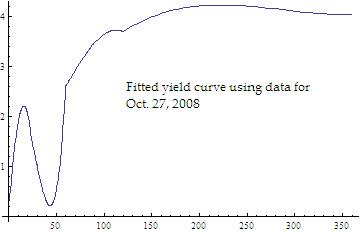Treasury note data is as of
5:22 p.m. EDT 10/16/08
(Treasuries data is from WSJ.com.)
1-Month Bill* 2/32 0.091
3-Month Bill* 8/32 0.497
6-Month Bill* 8/32 1.147
2-Year Note* -5/32 1.637
5-Year Note* -5/32 2.852
10-YR Note* -6/32 3.970
30-Year Bond* -1 1/32 4.254
It is interesting that the 1-month note bears an interest
rate of near zero.
Even though the short term inter-rate bank lending rate is very
high, the Federal rate is near zero.
The Fed has been pushing down short term interest rates by
instrumenting rate cuts. They keep pushing down the short end
when it rises and this keeps the yield curve from inverting.
Yield curve inversion, which we do not have here, is one
indication of a recession.
The yield curve using data points is shown below.

And the fitted curve is given next.




